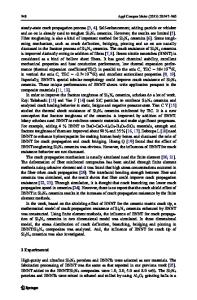Reversible bending of Si 3 N 4 nanowire
- PDF / 357,767 Bytes
- 4 Pages / 612 x 792 pts (letter) Page_size
- 46 Downloads / 296 Views
A reversible bending phenomenon of Si3N4 nanowires on the conductive carbon–formalin microgrid under an illumination of electron beam was observed using a transmission electron microscope. The nanowires exhibit high flexibility. The bending deflection is approximately proportional to the square of the current density (J) of the electron beam. The bending strength of Si3N4 nanowire is much higher than that of bulk Si3N4 materials. The force that bent the nanowires may be an electrostatic force.
Because of size effect, fibers and whiskers exhibit many unusual properties.1 For example, single SiC whiskers exhibit very high tensile strength and elastic modulus.2 It is expected that the nanowires or nanotubes should have some more specific properties. In fact, many studies have found that carbon nanotubes have exceptionally high Young’s modules (Y). Treacy et al. estimated the Y of isolated nanotubes by measuring the amplitude of intrinsic thermal vibrations of carbon nanotubes in a transmission electron microscopy (TEM) and found Y in the TPa range.3 With atomic force microscopy (AFM), Wong et al. determined that Young’s module of an individual multiwall carbon nanotube (MWNT) is about 1.28 ± 0.59 TPa.4 These experimental results were very similar to the theoretical calculation. Herna´ndez et al. obtained Y of carbon nanotubes as 1.26 TPa from the calculation of tight-binding theory.5 Yao et al. reported that Y of single-wall carbon nanotubes is about 1 TPa using a molecular simulation calculation.6 Besides high strength, carbon nanotubes have good flexibility.6–9 Multiwall carbon nanotubes could be bent repeatedly through large angles by using the tip of an atomic force microscope without undergoing cataclysmic failure.7 By a simple way, changing the current density of an electron beam in a TEM,8 MWNTs were found bending to an angle about 90° and relaxing to their original shape without any damage. Recently, electrically induced static and dynamic bending of carbon nanotubes was observed, and the experiment may supply the most reliable technique for measuring the bending modules of nanotubes.9 Additionally, SiC nanowires were found to
a)
Address all correspondence to this author. e-mail: [email protected]
1048
http://journals.cambridge.org
J. Mater. Res., Vol. 15, No. 5, May 2000 Downloaded: 20 Mar 2015
have high strength and better flexibility.4 In this work, the mechanical properties of Si3N4 nanowires are investigated with the aid of TEM. The force that made the nanowires bend is analyzed. The Si3N4 nanowires were synthesized through a carbon nanotube-confined reaction.10 These nanowires were dispersed in CH3COOH by ultrasound and then dropped on a conductive carbon–formalin microgrid. The observations were made with a JEM-2010F TEM, (JEOL Ltd., Tokyo, Japan) operating at 200 kV. The nanowire with one end clamped at the carbon film and the other end freely laid in a hole of the carbon film was selected in this experiment. The current density (J) of the electron beam illuminating the sample was calculat
Data Loading...











